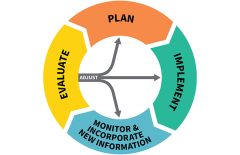Adaptive Management, Monitoring, and Analysis
Adaptive Management
Adaptive management is a structured, cyclical process for resource management decision-making. Feedback from monitoring is used to actively test assumptions when there is uncertainty and changing conditions. Monitoring data tracks relevant conditions over time, and measures management effectiveness.
Key principles of adaptive management:
Encourage continuous learning.
Acknowledge uncertainty.
Be action oriented.
Promote transparency.
Management of national forests and grasslands can be adaptive through land management and project planning. Adaptive management provides experience and knowledge to improve future management decisions. The 2012 Planning Rule provides an efficient and effective planning process and that includes an adaptive management framework. Our ability to adapt Land Management Plans as new information becomes available is critical for work to be responsive to dynamic ecological, social, and economic needs and conditions. The NEPA handbook (1909.15, Chapter 50) also outlines how monitoring informs potential adaptations of management actions.
Monitoring
Managing adaptively requires analysis of monitoring data to actively test assumptions, track relevant conditions over time and measure management effectiveness. As used in natural resource management, monitoring is the systematic collection and analysis of repeated observations or measurements to evaluate changes in natural resource, social and economic conditions, and progress toward meeting management objectives. Meaningful monitoring provides information on specific resources, management impacts, and overall trends. Based on the evaluation of the results of monitoring efforts, we make decisions and design on-the-ground projects and programs. Through monitoring and data evaluation, we may learn that we are not achieving what was expected, which would merit the need to change the land management plan, management activities, monitoring strategies, or perhaps reassess current conditions and trends. Monitoring data is based on accurate, reliable, and relevant science and Indigenous Knowledge. The accuracy and replicability of monitoring data and the methods used to analyze the data through time and space is core to our ability to ensure that we are developing monitoring programs that benefit public needs.
Land Management Plan Monitoring Program
A plan monitoring program is one of the core components of all land management plans. National forests and grasslands must conduct monitoring that addresses the monitoring questions in the plan. The plan monitoring program is designed to test whether assumptions made during the planning process are accurate and track progress towards the desired conditions in the land management plan.
Example Plan Monitoring Programs
Biennial Monitoring and Evaluation Reports
Every two years, each forest or grassland compiles monitoring results and drafts a report that documents and evaluates monitoring results and provides recommendations for potential changes to plan components, the monitoring program, or management activities. Analyses from results, evaluations from new or existing projects, resource program monitoring, or other existing databases can be used as data sources to help inform the evaluations. Land managers use these Biennial Monitoring Evaluation Reports to update their knowledge and assess progress toward the desired conditions. These reports are commonly posted on the national forest or grassland’s website.
Examples of Biennial Monitoring and Evaluation Reports
Broader-scale Monitoring Strategy
A broader-scale monitoring strategy is another important adaptive management tool designed to answer socioeconomic and ecological questions common to several forests or grasslands. The broader-scale monitoring strategy is developed by regional foresters with input from forest and grassland supervisors. The data for the broader-scale monitoring strategy is updated every five years.
Examples of Broader-Scale Monitoring Strategy
Participatory Science and Crowdsourcing
Participatory science, also knowns as citizen science, is when the public takes part in the scientific process, including forming research questions, collecting, analyzing, and making conclusions about data, or developing new technologies and applications. Crowdsourcing is a method to obtain needed services, ideas, or content by soliciting voluntary contributions from a group of individuals or organizations, especially from an online community. Participatory science and crowdsourcing bring together two important Forest Service values — using sound science to guide our management and decision-making, and connecting our work to the public that we serve.


